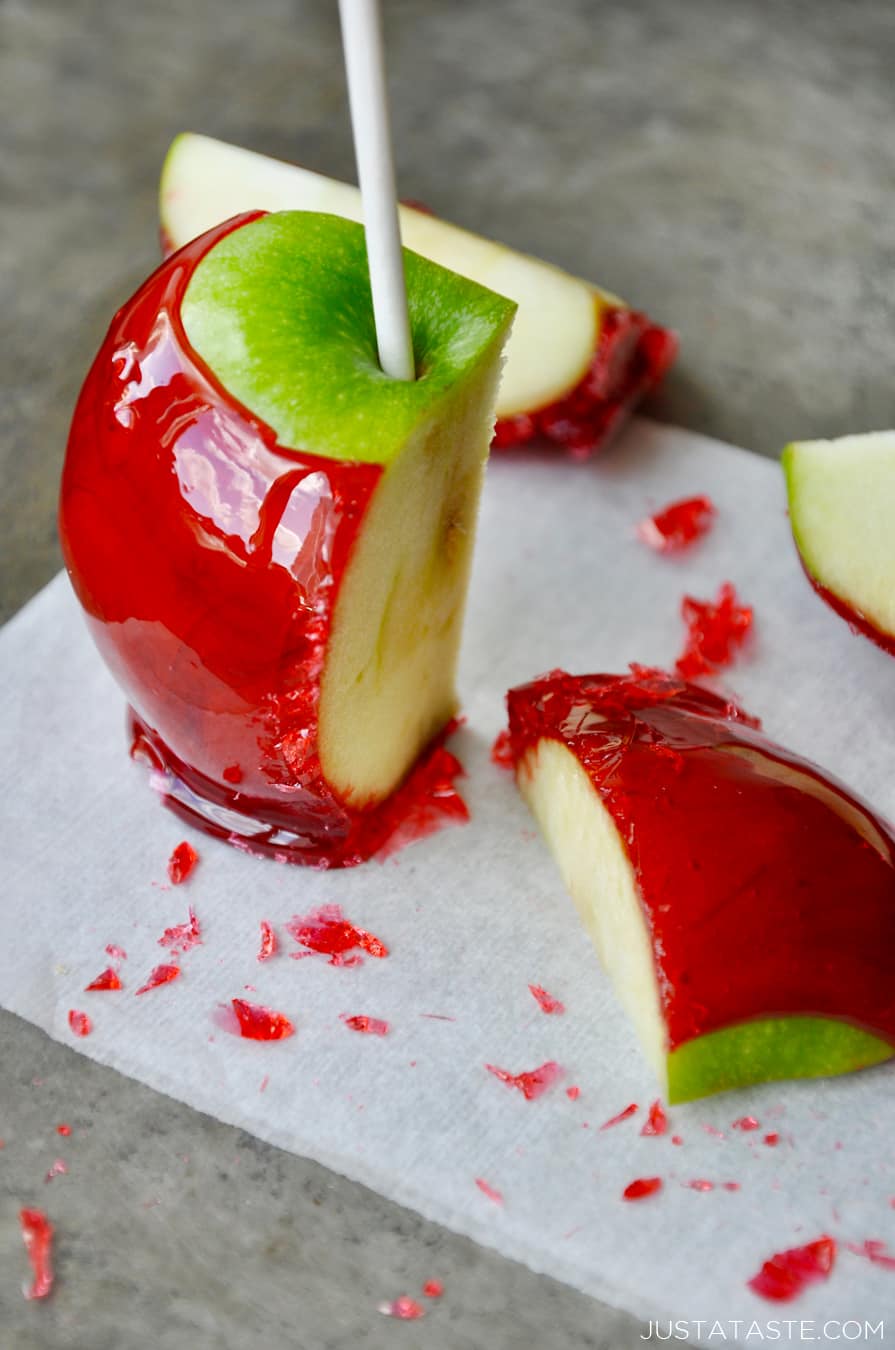For orders of this size, there may be a delay of up to 3 business days to process and ship. For questions or help with this order, please contact our team directly at 1-888-525-2462. Welcome to Rocky Mountain Chocolate Factory. Toggle navigation. Here at Amy's Gourmet Apples, we're proud to offer high-quality caramel chocolate apples and confections crafted from the finest ingredients. With an incredible range of toppings and flavors available, our caramel candy apples offer something for every occasion. Sweet candy apples with a hard, red, shiny candy coating. When you have all the necessary candy apple supplies on hand, you can either dip custom orders in front of patrons, or you can prepare apples in advance and package them in plastic candy apple bubbles. From salted pretzel caramel apples to toffee nut apples, you’ll have an enticing menu your guests won’t be able to resist.
Candy apple coated with red caramel and covered with chopped peanuts | |
| Alternative names | Toffee apple |
|---|---|
| Type | Confectionery |
| Place of origin | United States |
| Created by | |
| Main ingredients | Apples and sugar candy |
Candy apples (or toffee apples in Commonwealth English) are whole apples covered in a sugarcandy coating, with a stick inserted as a handle. These are a common treat at fall festivals in Western culture in the Northern Hemisphere, such as Halloween and Guy Fawkes Night because these festivals occur in the wake of annual apple harvests.[1] Although candy apples and caramel apples may seem similar, they are made using distinctly different processes.
History[edit]
According to one source, American William W. Kolb invented the red candy apple.

Kolb, a veteran Newark candy-maker, produced his first batch of candied apples in 1908. While experimenting in his candy shop with red cinnamon candy for the Christmas trade, he dipped some apples into the mixture and put them in the windows for display. He sold the whole first batch for 5 cents each and later sold thousands yearly. Soon candied apples were being sold along the Jersey Shore, at the circus and in candy shops across the country, according to the Newark News in 1948.[2]
Ingredients and method[edit]
Candy apples are made by coating an apple with a layer of sugar that has been heated to hard crack stage.[3][unreliable source?] The most common sugar coating is made from sugar (white or brown), corn syrup, water, cinnamon and red food coloring. Humid weather can prevent the sugar from hardening.[4]
Regional traditions[edit]
- Australia – the Granny Smith variety of apple is considered ideal for creating the children's treat.[5]
- Brazil – candy apples (named as in other Lusophone countries maçã do amor, as in the Frenchpommes d'amour, meaning 'apples of love') are common in the festivities in honor of John the Apostle.
- China – a similar treat called Tanghulu is made by coating small fruits, traditionally hawthorns with hard sugar syrup.
- Canada – very popular and usually eaten at fairs or carnivals.
- France – candy apples are called pommes d'amour (apples of love). They are a common treat found at many festivals in France.
- Germany – most often associated with the Christmas season. They are also sometimes sold at carnivals and fairs
- Israel – almost solely sold in cities' squares on Yom Ha'atzmaut eve (Israel Independence Day) as part of the street celebrations.
- Japan – candy apples, grapes, strawberries and tangerines are commonly available at Japanese festivals.[6]
- Republic of Ireland – eaten at Halloween.
- United Kingdom – a similar treat made with toffee is associated with and eaten at Halloween (Scotland and Northern Ireland), Bonfire Night (England and Wales).
- United States – jelly apples, found in New York's Coney Island area, are related but have a soft candy ('jelly') coating and a cherry flavor, not cinnamon.[citation needed]
- South Africa - Toffee apples are mostly available at supermarkets like Checkers and Spar. They are also very popular throughout apple season.Mostly dipped in red or green coloured sugar syrup.
Urban myth[edit]
During the 1960s and 1970s, news reports about children supposedly receiving candy apples with pins and razor blades in them, created concern during Halloween in the United States. Hospitals offered free x-rays to detect foreign objects in the candy apples. To date, the stories have never been substantiated and fall into the category of urban legend.[7]
See also[edit]
References[edit]
- ^ThisisSouthDevon (October 9, 2008). 'Apples galore as event grows'. Torquay Herald Express. Torquay, Devon, UK: localworld.co.uk. Archived from the original on October 3, 2015. Retrieved November 17, 2013.
- ^Newark Sunday News, November 28, 1948, pg.16.Newark Evening News, June 8, 1964, pg. 32
- ^Flickety; et al. 'How to make Toffee Apples'. WikiHow. Archived from the original on March 5, 2014. Retrieved February 17, 2014.
- ^'Caramel Apples vs. Candy Apples. Tart Green Granny Smith apples work very well for making candy apples'. St. Petersburg Times. October 24, 2001. Retrieved October 22, 2010.
- ^'Designer Toffee Apples'. Designer Toffee Apples. Retrieved February 17, 2014.
- ^Celeste Heiter; Things Asian Press (November 1, 2009). To Japan with Love: A Travel Guide for the Connoisseur. ThingsAsian Press. pp. 127–. ISBN978-1-934159-05-7. Retrieved November 11, 2011.
- ^'The History of Halloween'. The History of Halloween. Archived from the original on July 24, 2011. Retrieved October 22, 2010.
External links[edit]
- Media related to Candy apples at Wikimedia Commons
Candy Apple Paint
